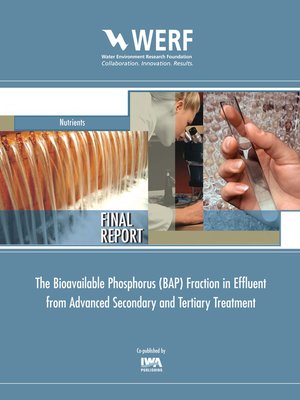The Bioavailable Phosphorus (BAP) Fraction in Effluent from Advanced Secondary and Tertiary Treatment
ebook ∣ WERF Research Report
By Michael T. Brett

Sign up to save your library
With an OverDrive account, you can save your favorite libraries for at-a-glance information about availability. Find out more about OverDrive accounts.
Find this title in Libby, the library reading app by OverDrive.



Search for a digital library with this title
Title found at these libraries:
| Library Name | Distance |
|---|---|
| Loading... |
Due to the widespread severity of eutrophication in surface waters, there is a strong impetus to require ultra-low effluent phosphorus (P) concentrations (i.e., 50%) of the effluent P was recalcitrant to algal growth. Comparisons between different technologies indicate higher chemical doses, which also achieved lower effluent P concentrations, decreased the fraction of the phosphorus that was bioavailable (BAP%). The results also suggest that the effluent total reactive phosphorus (TRP) concentration has, of the operational characterization assessed, the strongest statistical associated (r2 = 0.81) with the total effluent BAP concentration with the average BAP to TRP ratio of 0.61 ± 0.24. The results of this work should encourage water quality modelers and TMDL permit writers to consider the importance of BAP when assessing the likely ecological impacts of municipal nutrient removal facility effluent discharges.
The bioavailability of a variety of well-defined P containing compounds was also characterized. The results clearly show the operationally defined P classification scheme from classic chemical methods is problematic. Algal phosphorus uptake experiments also suggest that P species with high bioavailability, including some organic P species, are unlikely to persist in natural surface waters because their uptake kinetics are very rapid. These results further suggest recalcitrant P compounds, such as humic-metal-P complexes, phytic acid and/or apatite may be the dominant components of the recalcitrant dissolved P pool in effluents identified in this and other studies.
The bioavailability of a variety of well-defined P containing compounds was also characterized. The results clearly show the operationally defined P classification scheme from classic chemical methods is problematic. Algal phosphorus uptake experiments also suggest that P species with high bioavailability, including some organic P species, are unlikely to persist in natural surface waters because their uptake kinetics are very rapid. These results further suggest recalcitrant P compounds, such as humic-metal-P complexes, phytic acid and/or apatite may be the dominant components of the recalcitrant dissolved P pool in effluents identified in this and other studies.







